Guides
Dmitri’s, Effie’s, and Little Pete’s may be gone, but you can still get great Greek food if you know where to look.
Devoted foodies and restaurant newbies love Foobooz. Sign up now for our twice weekly newsletter.
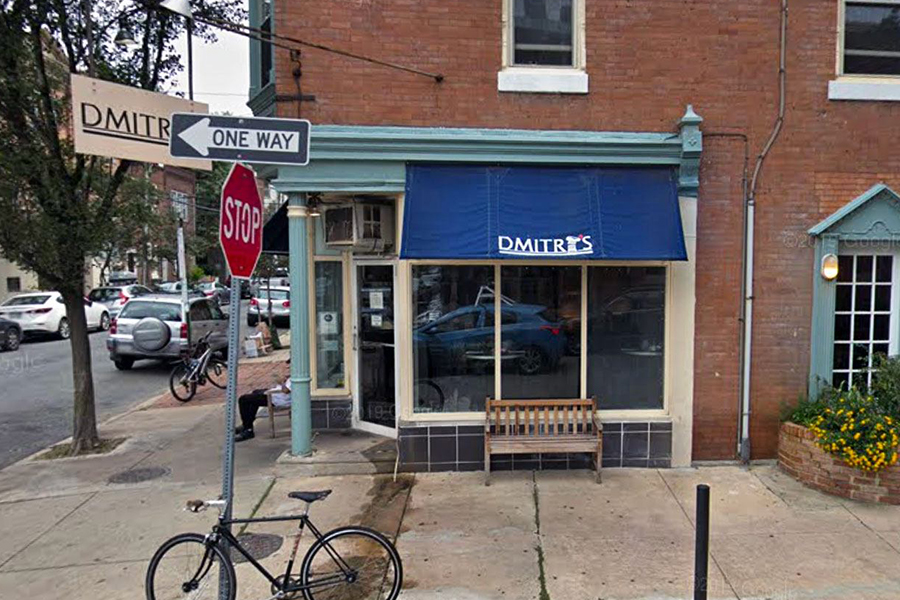
Dmitri’s Queen Village / Image from Google Maps
Antonis Dalagelis orders the grilled branzino when he dines out, just as he has for decades. “There’s Greek branzino, and then there’s other branzino,” he says. Living around Greeks for about 10 years now, I thought this was charming Hellenic hyperbole, but it turns out that many Greek fisheries do not raise their branzino in farms. Instead, they operate open-ocean pens in the Aegean Sea. Dalagelis knows his fish. Even though he moved on from managing South Street Souvlaki in 1996, he’s stayed close to the Greek kitchens of Philadelphia.
South Street Souvlaki has been a Philly institution for almost 50 years, and Dalagelis was there in its halcyon days. While South Street has lived through many iterations, the restaurant has remained comfortingly the same, even after owner Tom Vasiliades turned the business over to longtime employee Ismael Mercado in 2019. Mercado may not be Greek, but he was trained by Greeks. Its blue and white takeout window still offers gyros and kebabs in beef, lamb, or chicken; dolmades (grape leaves stuffed with rice and meats) and spanakopita spinach pies to go; and blasts rebetiko music until late into the night. The menu is a replica of what would be served by a yiayia (Greek for “grandmother”) but somehow fits in with the chaos of South Street.
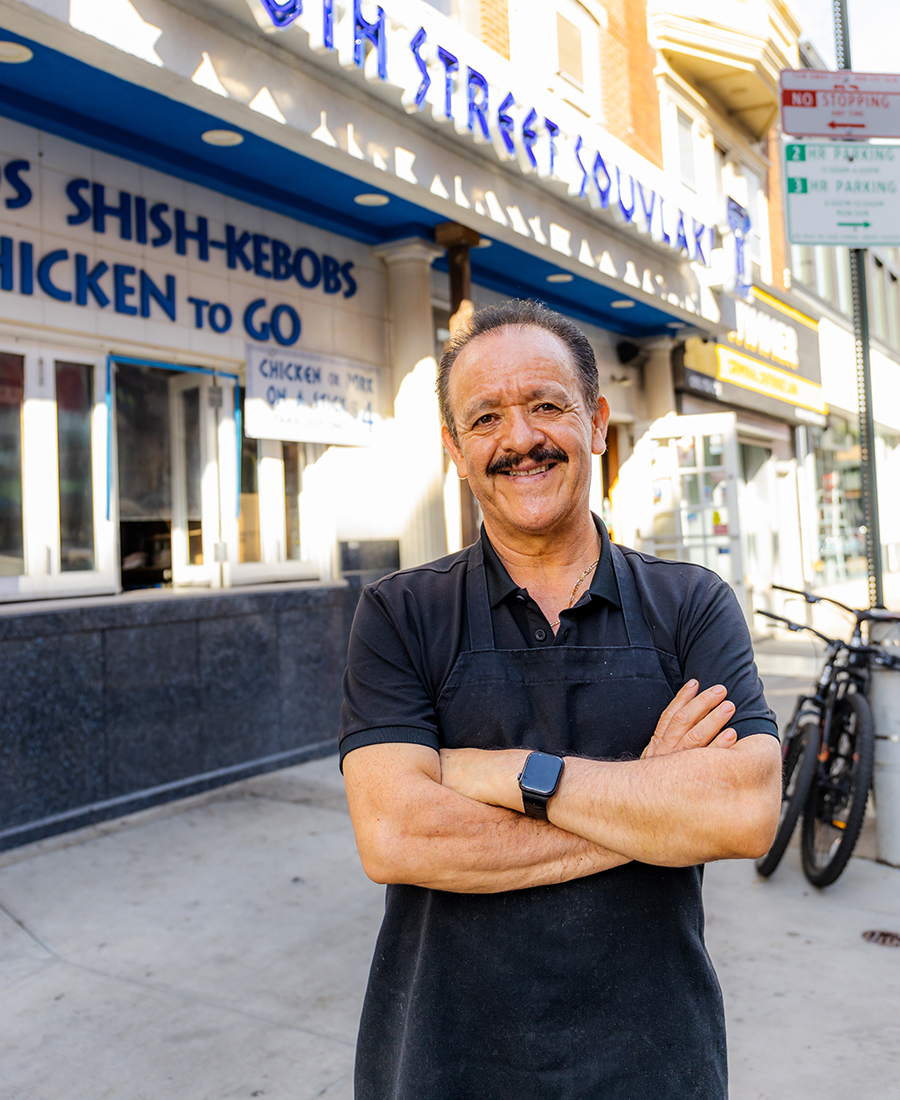
Ismael Mercado, the current owner of South Street Souvlaki / Photograph by Daniel Knoll for Visit Philadelphia
The restaurant is a reminder of the years from the 1960s through the ’80s when a “second wave” of approximately 200,000 Greeks came to the U.S. to escape the military junta that ruled the country at that time, with Philadelphia welcoming at least 20,000 of them. They immigrated from all over Greece, but many from Zagori villages in the Pindus Mountains in the Northwest, like Demati, Ioannina, and Petra — where Dalagelis is from — and settled in neighborhoods from Upper Darby to Center City.
The ones who settled here took on labor jobs — as tailors, jewelers, and working in kitchens. Operating as dishwashers and line cooks led to many taking over diners from other immigrant groups. Regional community groups, like the Pan-Macedonia Association or the Brotherhood of Demati, established clubhouses for gatherings, like the Brotherhood’s annual panigiri, or traditional dancing event, which helped to create a hiring network. The Greek-run diners became known for quick-cook dishes, like huge French fry and salad platters similar to what you’d eat at a taverna. They subbed in hamburgers for gyros; and the concept of bottomless coffee breaks is pure kafenio – Greek coffee house.
In 2023, Greek American news site Cosmos Philly celebrated this heritage with a documentary about restaurant families called Greek Diners & Restaurants: The Start of The American Dream, and I found myself at a table filled with people who had emigrated from the Ioannina region talking about their experiences in kitchens in those early days. There were big cups of coffee, personal photographs, and a 16-page list of everyone who participated.
Watching dozens of families reconnect, chefs from Century Diner and the Cherry Hill Diner, and distributors like Lacas Coffee, I realized it’s a safe bet that a Greek immigrant influenced a meal you love in Philadelphia.
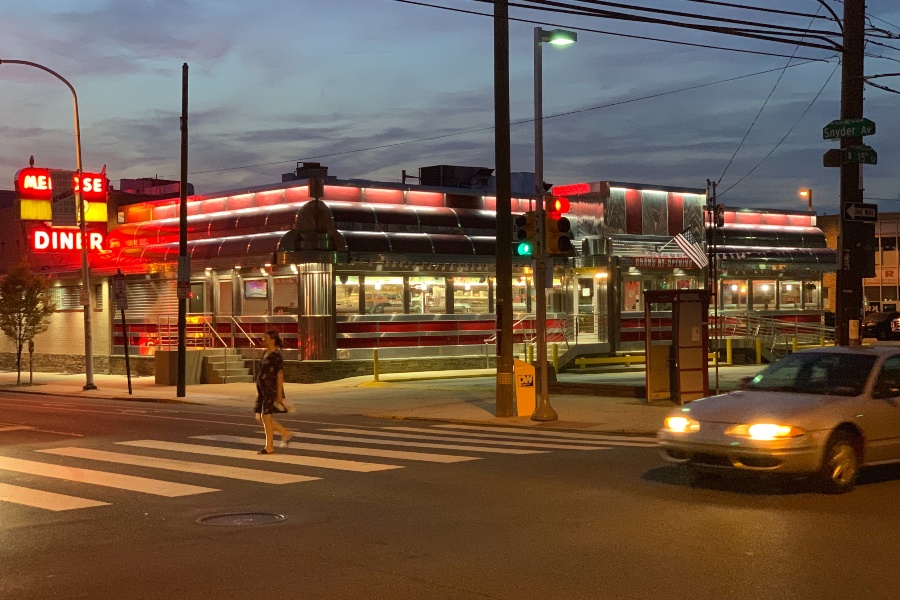
Everybody who knows goes to Melrose / Photograph by Alex Tewfik
That community looks different today. There’s a steady stream of diners closing: the Midtown III in 2020, the Melrose in 2022, and the Collingswood Diner in August 2025 (just to name a few), as well as plans for Broad Street Diner to turn into a Hyatt Hotel and Mayfair Diner going up for sale. We’ve also said goodbye to beloved spots like Dmitri’s and Effie’s, but tavernas keep going. If you ask Dalagelis, “If you want real Greek food, don’t go to the diner.”
Pete Koutroubas, better known as Little Pete, has been washing dishes since 1978 and was still washing dishes when I met him at his Fairmount diner on a September afternoon. In fact, most of his stories about working in the restaurant business revolve around washing dishes, or the patrons he’s connected with. This location is the third iteration of Little Pete’s restaurants. The original sat at 17th Street and Chancellor for almost 40 years, hosting rebetiko music nights and becoming a reliable dinner spot for many in Center City.
Tastes have changed — “They want vegetables,” Koutroubas says — but people still order specialties like lamb with orzo. He still uses the same coffee beans (Lacas, of course) and meat vendors he always has. And he’s still visited by guests from his 17th Street days.
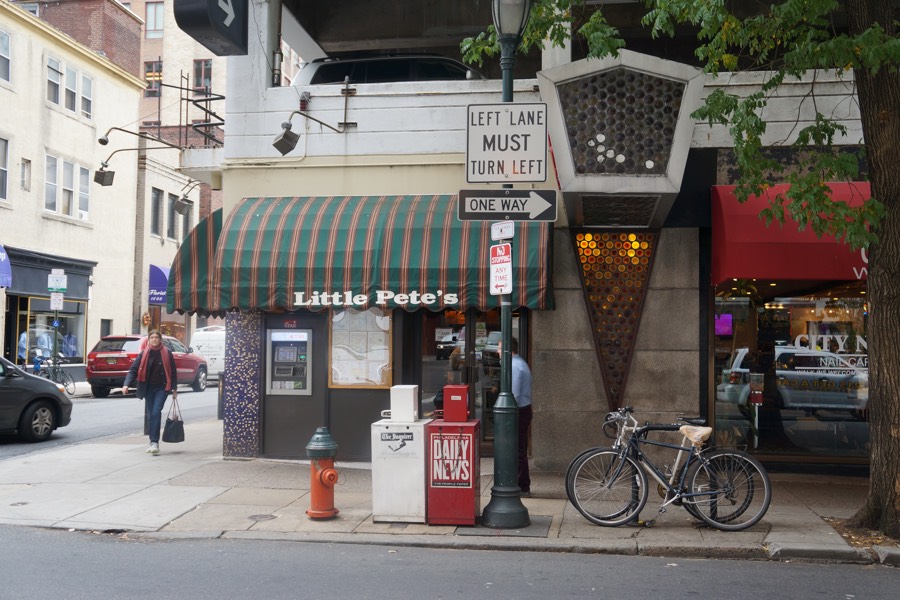
Little Pete’s Diner
With his chef, he’s considering a Greek menu night. “We brought out galaktoboureko and gave it to everyone,” Koutroubas says of the gooey custard pie. They liked it, but he’s unsure. After all, the Greek diner community isn’t around to lift each other up anymore. The Cosmos documentary party was the first time some had reconnected in many years.
“I came here when I was 30. I was living on 7th and Pine with other Greeks, and every night we’d go out,” Dalagelis says.
In fact, sharing a drink at South Street Souvlaki is how he caught the eye of Tom Vasiliades for his first kitchen job. He tells stories about the staff from South Street Souvlaki, Mykonos Taverna, and Dmitri’s getting together, sharing ideas and drinks. (“We had the best souvlaki,” he swears.) Eventually, chefs would move from one restaurant to the other.
It’s been years since Dalagelis has been in that South Street Souvlaki kitchen, but his work is evident on specialties like prasopita and the leek and cornmeal spanakopita from his village, Petra. It may not be served to you by a Zagori native, but you can still order it at the takeout window on your way to a show at the TLA.
Koutroubas brings up his own retirement a few times. He hasn’t returned to the Zagori in years. “I’d like to spend some time there,” he reminisces. Although he has children and other family nearby, they have not gone into the food industry. There’s no one to take over once he leaves.
But his old 17th Street plot is in Greek hands. Almyra opened in 2023, serving “modern” Mediterranean. A trained eye will note Cretan salad on the menu, differentiated from standard horiatiki salad by its crusty rusk. Mona, a 2024 Center City addition, features loud music, spicy mezze, and fig cocktails you can swig in a bar resembling Santorini. But also, avgolemono, a creamy lemon soup known to all cold-stricken Greek children. The marketing says Mediterranean, but taverna food lives on in Philly if you know what to look for.
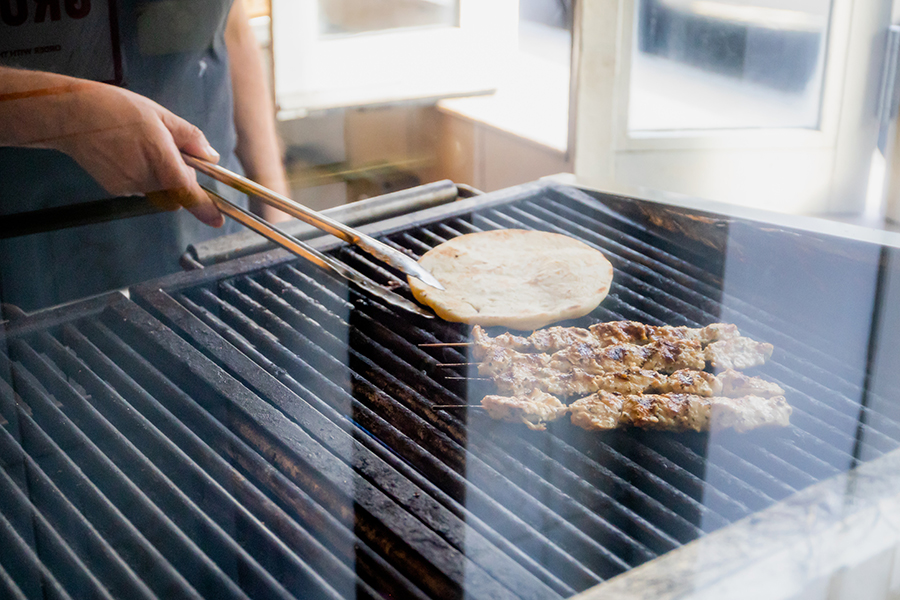
Kebabs at South Street Souvlaki / Photograph by Daniel Knoll for Visit Philadelphia
Saganaki at Kostas Restaurant, Fishtown
This Fishtown spot has a great saganaki plate — the block of thick cheese you’ve seen lit on fire in movies. They use Kasseri, a sheep and goat’s milk cheese from the mountain regions, rather than feta. This dish comes with pita bread, but you can eat it right from the fork; no accoutrements necessary. 15 West Girard Avenue.
Lamb Dishes at Zorba’s Tavern, Fairmount
Lamb dishes are the trademark of a Greek restaurant, and you’ll find several here. In fact, they’re some of Dalageslis’s favorites. Stick with the fourno, with lemon sauce, or kapama, with tomato sauce. And add gemista, a tomato stuffed with rice and herbs. 2230 Fairmount Avenue.
Grill House Platter at Elia Greek Cuisine, Glenside
To sample a little of everything, go for the mixed grill platter with lamb, sausage, and pork. Add a slice of Black Forest cake, a classic taverna dessert, and BYO tsipouro, a brandy from Epirus. 264 North Keswick Avenue.
Spreads Pikilia at Estia, Center City
The fish dishes are great at Estia, but for a super Greek experience, order the assortment of dips, like taramasalata, a salty roe dip; and melitzanosalata, with smokey charred eggplant. Eat them straight off pillowy pita bread. 1405 Locust Street.
Beets with Yogurt at Kanella, Washington Square West
It doesn’t get anymore Cretan than the beets with yogurt served with arugula, honey, and walnuts. End your meal with Turkish coffee and kenefe and you’ll feel like you’ve escaped to Greece’s largest island. 1001 Spruce Street.
Kebabs at South Street Souvlaki, Society Hill
Have you even been to South Street if you haven’t stopped by the iconic blue and white window for a quick kebab? Pick between beef, lamb, or chicken. Don’t worry — there’s no wrong choice here. 509 South Street
Frappe at Greek From Greece Marketplace, University City
A sweet, strong iced coffee made from Nescafé kernels, a frappe is often the first snack consumed when landing in Athens, since it’s difficult to find in the States. It’s a popular cold treat during sweaty Greek summers, but you can get this one right in Philadelphia. Order it without extra sugar for the strongest taste. 107 North 33rd Street.
Homemade Snacks at Greek Festivals, Washington Square West and Upper Darby
Greek church fests are a cornucopia of homemade food. At St. George Greek Orthodox Cathedral, folks named George can score pastitsio, a thick, meaty lasagna, on their “name day,” the day honoring Saint George, April 23rd. Meanwhile, St. Demetrios hosts their festival in May, featuring a loukoumades stand where you can drown the nugget-shaped doughnuts in honey and nuts. Check the Greek American Heritage Society of Philadelphia for event notices. 256 South 8th Street; 229 Powell Lane.
Home Cooking Ingredients at N & E Agora Market, Northeast Philadelphia
This grocery in Mayfair has a wealth of straight-from-Greece products, but the rolls of ready-to-heat phyllo and bricks of feta cheese are worth the trip alone. 917 Tyson Avenue.


Dining and Cooking